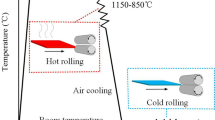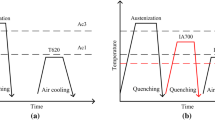Abstract
Transformation of metastable austenite into martensite in novel quenched & partitioned (Q&P) steels improves sheet formability, allowing this class of high-strength steels to be used for automotive structural components. The current work studies the microstructural evolution by varying intercritical annealing time (t a), as well as its influence on the martensite-austenite constituent and mechanical properties of Q&P steels. As the t a was prolonged, the morphology of retained austenite progressively transformed from block to a mixture of block and film, and finally changed to totally film. Based on electron back-scatter diffraction (EBSD) measurements and uniaxial tensile response, the holding time of 600 s at 760 °C was determined to produce the best results in terms of highest volume fraction of retained austenite (f γ = 15.8%) and largest strain (26.8%) at the ultimate tensile strength (892 MPa). This difference in work-hardening behavior corresponds directly to the transformation rate of retained austenite with different morphology. The slower rate of transformation of filmy austenite allowed for work hardening to persist at high strains where the transformation effect had already been exhausted in the blocky one. There is great potential for properties improvement through adjustment of metastability of retained austenite.






Similar content being viewed by others
References
Y.I. Son et al., Ultrafine Grained Ferrite–Martensite Dual Phase Steels Fabricated Via Equal Channel Angular Pressing: Microstructure and Tensile Properties, Acta Mater., 2005, 53, p 3125–3134
B.C. De Cooman, Structure–Properties Relationship in TRIP Steels Containing Carbide-Free Bainite, Curr. Opin. Sol. State Mat. Sci., 2004, 8, p 285–303
P. Jacques et al., Multiscale Mechanics of TRIP-Assisted Multiphase Steels: I. Characterization and Mechanical Testing, Acta Mater., 2007, 55, p 3681–3693
J. Speer et al., Carbon Partitioning into Austenite After Martensite Transformation, Acta Mater., 2003, 51, p 2611–2622
D. Edmonds et al., Quenching and Partitioning Martensite—A Novel Steel Heat Treatment, Mater. Sci. Eng. A, 2006, 438, p 25–34
R. Zhu et al., Phase Constitution Effect on the Ductility of Low Alloy Multiphase Transformation Induced Plasticity Steels, Mater. Sci. Eng. A, 2013, 569, p 137–143
R. Zhu et al., Multi-Phase Microstructure Design of a Low-Alloy TRIP-Assisted Steel Through a Combined Computational and Experimental Methodology, Acta Mater., 2012, 60, p 3022–3033
G.K. Tirumalasetty et al., Deformation-Induced Austenite Grain Rotation and Transformation in TRIP-Assisted Steel, Acta Mater., 2012, 60, p 1311–1321
S. Li et al., Thermodynamic Analysis of Two-Stage Heat Treatment in TRIP Steels, Acta Mater., 2012, 60, p 6120–6130
M. Santofimia, L. Zhao, and J. Sietsma, Overview of Mechanisms Involved During the Quenching and Partitioning Process in Steels, Metall. Mater. Trans. A, 2011, 42, p 3620–3626
M. Santofimia, L. Zhao, and J. Sietsma, Microstructural Evolution of a Low-Carbon Steel During Application of Quenching and Partitioning Heat Treatments After Partial Austenitization, Metall. Mater. Trans. A, 2009, 40, p 46–57
P.J. Jacques, The Fracture Toughness of TRIP-Assisted Multiphase Steels, Acta Mater., 2008, 56, p 3900–3913
R. Kuziak, R. Kawalla, and S. Waengler, Advanced high Strength Steels for Automotive Industry, Arch. Civil Mech. Eng., 2008, 8, p 103–117
J.P.G. Kliber, O. Zacek, M. Soman, Effects of Thermomechanical Processing on Microstructure and Mechanical Properties Multiphase Steels Exhibiting a TRIP Effect. Trans. Tech. Publications, 2007, p 4357.
E. De Moor et al., Effect of Retained Austenite Stabilized Via Quench and Partitioning on the Strain Hardening of Martensitic steels, Metall. Mater. Trans. A, 2008, 39, p 2586–2595
P. Jacques, Transformation-Induced Plasticity for High Strength Formable Steels, Curr. Opin. Solid State Mat. Sci., 2004, 8, p 259–265
S. Lee, S.J. Lee, and B.C. De Cooman, Austenite Stability of Ultrafine-Grained Transformation-Induced Plasticity Steel with Mn Partitioning, Scripta Mater., 2011, 65, p 225–228
H. Luo, Comments on “Austenite Stability of Ultrafine-Grained Transformation-Induced Plasticity Steel with Mn Partitioning”. by S. Lee, SJ Lee and BC De Cooman, Scripta Mater. 65 (2011) 225–228. Scripta. Mater., 2012. 66, p 829–831
R.M. Wu et al., Stability of Retained Austenite Through a Combined Intercritical Annealing and Quenching and Partitioning (IAQP) Treatment, Acta Metall. Sinica (Eng. Lett.), 2015, 28, p 386–393
I. Timokhina, P. Hodgson, and E. Pereloma, Effect of Microstructure on the Stability of Retained Austenite in Transformation-Induced-Plasticity Steels, Metall. Mat. Trans. A, 2004, 35, p 2331–2341
R. Miller, A Rapid X-ray Method for the Determination of Retained Austenite, Trans. ASM, 1964, 57, p 892–899
L. Cheng et al., Lattice Changes of Iron-Nitrogen Martensite on Aging at Room Temperature, Metall. Trans. A, 1990, 21, p 2857–2867
D. Dyson and B. Holmes, Effect of Alloying Additions on the Lattice Parameter of Austenite, J Iron Steel Inst., 1970, 208, p 469–474
L. Zhao et al., Magnetic and X-ray Diffraction Measurements for the Determination of Retained Austenite in TRIP Steels, Mat. Sci. Eng. A, 2001, 313, p 145–152
X. Zhu et al., Improved Resistance to Hydrogen Embrittlement in a High-Strength Steel by Quenching–Partitioning–Tempering Treatment, Scripta Mater., 2015, 97, p 21–24
F.G. Caballero and H.K.D.H. Bhadeshia, Very Strong Bainite, Curr. Opin. Solid State Mat. Sci., 2004, 8, p 251–257
X.C. Xiong et al., The Effect of Morphology on the Stability of Retained Austenite in a Quenched and Partitioned Steel, Scripta Mater., 2013, 68, p 321–324
H.Y. Li et al., Bainitic Transformation During the Two-Step Quenching and Partitioning Process in a Medium Carbon Steel Containing Silicon, Mat. Sci. Eng. A, 2010, 527, p 6255–6259
J. Shi et al., Enhanced Work-Hardening Behavior and Mechanical Properties in Ultrafine-Grained Steels with Large-Fractioned Metastable Austenite, Scripta Mater., 2010, 63, p 815–818
Y. Tomita and K. Okabayashi, Improvement in Lower Temperature Mechanical Properties of 0.4pct. C-Ni-Cr-Mo Ultrahigh Strength Steel with the Second Phase Lower Bainite, Metall. Trans. A, 1983, 14, p 485–492
J. Zhang, H. Ding, and R.D.K. Misra, Enhanced Strain Hardening and Microstructural Characterization in a Low Carbon Quenching and Partitioning Steel with Partial Austenization, Mat. Sci. Eng. A, 2015, 636, p 53–59
E. Jimenez-Melero et al., Martensitic Transformation of Individual Grains in Low-Alloyed TRIP Steels, Scripta Mater., 2007, 56, p 421–424
V.S.A. Challa et al., Significance of Interplay Between Austenite Stability and Deformation Mechanisms in Governing Three-Stage Work Hardening Behavior of Phase-Reversion Induced Nanograined/Ultrafine-Grained (NG/UFG) Stainless Steels with High Strength-High Ductility Combination, Scripta Mater., 2014, 86, p 60–63
P. Jacques, F. Delannay, and J. Ladrière, On the Influence of Interactions Between Phases on the Mechanical Stability of Retained Austenite in Transformation-Induced Plasticity Multiphase Steels, Metall. Mat. Trans. A, 2001, 32, p 2759–2768
R. Ding, D. Tang, and A. Zhao, A Novel Design to Enhance the Amount of Retained Austenite and Mechanical Properties in Low-Alloyed Steel, Scripta Mater., 2014, 88, p 21–24
Acknowledgments
This study is funded by National Natural Science Foundation of China (No. 51571141).
Author information
Authors and Affiliations
Corresponding author
Rights and permissions
About this article
Cite this article
Wu, R., Jin, X., Wang, C. et al. Effect of Intercritical Annealing on Microstructural Evolution and Properties of Quenched & Partitioned (Q&P) Steels. J. of Materi Eng and Perform 25, 1603–1610 (2016). https://doi.org/10.1007/s11665-016-1985-8
Received:
Revised:
Published:
Issue Date:
DOI: https://doi.org/10.1007/s11665-016-1985-8




